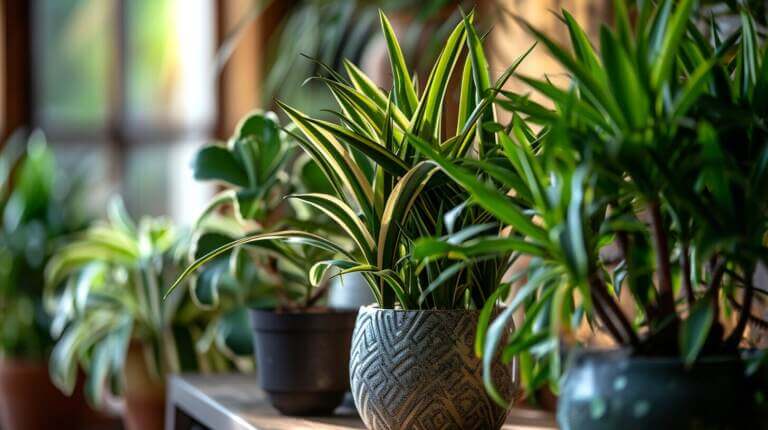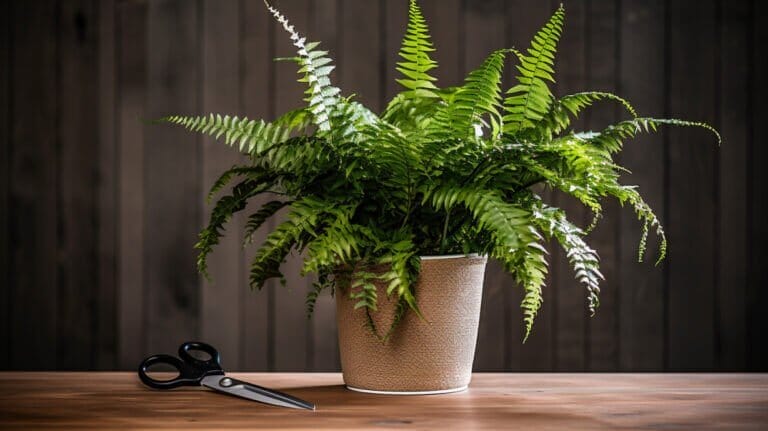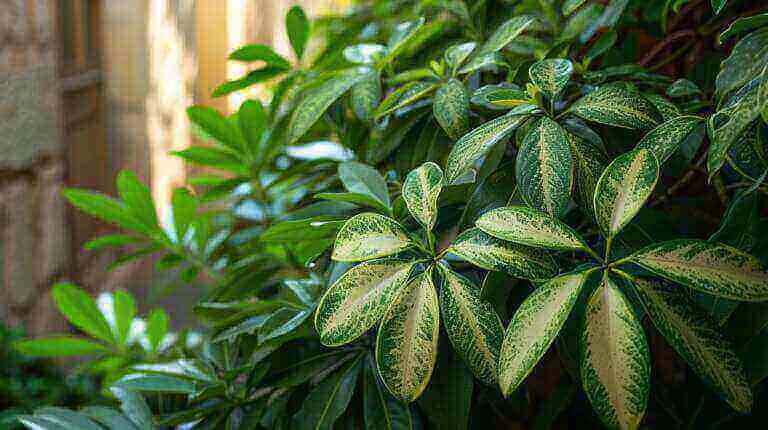Beginner’s Care Guide to Grow And Care For Ctenanthe Never Never Plant
If you’re looking to add a touch of tropical plant to your indoor space, ctenanthe indoor plants are a fantastic choice. With their vibrant foliage, unique leaf patterns, and fascinating nyctinasty behavior, these house plants are sure to capture your attention. In this guide, I’ll provide essential care tips and information you need to successfully grow and care for ctenanthe houseplants.
Key Takeaways:
- Choose a well-draining potting mix and provide bright, indirect light for your ctenanthe houseplant.
- Maintain high humidity levels by using a humidifier or placing your plant on a pebble tray with water.
- Water your ctenanthe when the top inch of soil feels dry, and fertilize monthly during the growing season.
- Prune away any dead or dying leaves to keep your plant looking healthy and vibrant.
- Watch out for common houseplant pests like spider mites and take appropriate measures to control them.
Ctenanthe Never Never Plant Care Tips
Proper care is essential for ensuring the health and vitality of your ctenanthe houseplant. By following these care tips, you can create the ideal environment for your plant to thrive.
Light:
Ctenanthe houseplants prefer medium to bright indirect light. Avoid placing them in direct sunlight as it can scorch the leaves. Position your plant near a window with filtered light or use sheer curtains to diffuse the sunlight.
Watering:
Keep the soil consistently moist but not soggy. Allow the top inch of soil to dry out between waterings and then thoroughly water the plant. Ensure good drainage to prevent waterlogged roots, which can lead to root rot. Monitor the moisture level regularly to avoid over or underwatering.
Humidity:
Ctenanthe plants thrive in high humidity environments. Use a humidifier to increase the moisture level around the plant or place it on a pebble tray filled with water. Misting the leaves regularly can also help maintain adequate humidity.
Fertilizing:
Feed your ctenanthe houseplant with a balanced houseplant fertilizer once a month during the spring and summer. Follow the instructions on the fertilizer packaging for the correct dosage. Avoid over-fertilizing, as it can lead to salt buildup in the soil.
Pruning:
Remove any dead or yellowing leaves regularly to maintain the plant’s appearance and health. Pruning also helps promote new growth. Use clean, sharp pruning shears and make clean cuts just above a leaf node.
Repotting:
Ctenanthe houseplants generally do not require frequent repotting. However, if the plant becomes rootbound, it’s time to repot it into a slightly larger pot with fresh, well-draining potting mix. Repotting is best done in the spring when the plant is actively growing.
Pest Control:
Keep an eye out for common houseplant pests like spider mites and mealybugs. If you notice any signs of infestation, take prompt action to control them. Treatments can include using insecticidal soap or neem oil, wiping the leaves with a damp cloth, or isolating the affected plant to prevent the spread of pests.
By providing the right care, your ctenanthe houseplant can flourish and beautify your indoor space. Remember to monitor its lighting, watering, humidity, and fertilization needs, and address any potential pest issues promptly. With a little attention and care, your ctenanthe will reward you with its stunning foliage and vibrant presence.
Types of Ctenanthe Houseplants
Ctenanthe houseplants come in a variety of beautiful species and cultivars, each with its own unique characteristics. Here are some popular types of ctenanthe houseplants:
Ctenanthe setosa
Ctenanthe setosa, also known as the Grey Star, is a stunning ctenanthe variety with lance-shaped leaves that have silver-gray undersides. The top of the leaves features a deep green color with intricate patterns of veins. This variety thrives in bright indirect light and requires a high humidity environment. Its unique foliage adds an elegant touch to any indoor space.
Ctenanthe oppenheimiana
Ctenanthe oppenheimiana, commonly known as the Never Never Plant, is a popular choice among houseplant enthusiasts. This variety boasts large, elongated leaves with vibrant green coloration and stunning patterns of deep purple undersides. Ctenanthe oppenheimiana prefers low to medium light conditions and thrives in high humidity environments. It adds a tropical touch to any home or office.
Ctenanthe burle-marxii
Ctenanthe burle-marxii, also known as the Fishbone Prayer Plant, is a visually striking ctenanthe variety. Its lance-shaped leaves have intricate patterns resembling fishbones, with a mix of dark and light green colors. This variety prefers bright indirect light and high humidity levels. Ctenanthe burle-marxii is a great choice for those looking to add a touch of elegance to their indoor spaces.
These are just a few examples of the diverse range of ctenanthe houseplants available. Each variety offers unique foliage patterns and colors, allowing you to find the perfect ctenanthe to suit your personal taste and style.
| Ctenanthe Variety | Characteristics |
|---|---|
| Ctenanthe setosa | Lance-shaped leaves with silver-gray undersides and green tops with intricate vein patterns |
| Ctenanthe oppenheimiana | Large, elongated leaves with vibrant green coloration and deep purple undersides |
| Ctenanthe burle-marxii | Lance-shaped leaves with fishbone-like patterns in dark and light green colors |
These beautiful ctenanthe houseplants, with their unique foliage patterns and colors, add a touch of elegance and tropical allure to any indoor space. Whether you choose Ctenanthe setosa, Ctenanthe oppenheimiana, or Ctenanthe burle-marxii, these plants are sure to bring joy and beauty to your home or office environment.
Propagating Ctenanthe Houseplants
Propagating ctenanthe houseplants is an exciting way to expand your collection or share these beautiful plants with friends and family. There are two main methods of propagation: division and stem cuttings.
Division
Division is a straightforward method of propagating ctenanthe houseplants. It is best done in the spring when the plant is actively growing. To divide a ctenanthe plant, carefully remove it from its pot, taking care not to damage the roots. Next, gently separate the clumps of leaves and roots, ensuring that each clump has some healthy foliage and root system intact. Plant the clumps in fresh potting mix, making sure to cover the roots adequately. Water the newly divided plants thoroughly and place them in a location with bright, indirect light.
Stem Cuttings
Another method of propagating ctenanthe houseplants is through stem cuttings. Start by selecting a healthy stem with several leaves. Using a clean, sharp knife or scissors, cut the stem just below a leaf node. Remove the lower leaves from the cutting, leaving a few at the top. Place the cutting in a small pot filled with moist potting soil or a mixture of perlite and peat moss. Ensure that the cutting is planted deep enough to provide support. Mist the cutting and cover it with a plastic bag to create a humid environment. Place the pot in a warm location with bright, indirect light. After a few weeks, roots should develop, indicating that the cutting has successfully rooted.
Propagation Tips
Regardless of the method you choose, it’s essential to provide the right conditions for successful propagation. Maintain a consistently moist but not soggy soil environment to encourage root development. Mist the newly propagated plants regularly to boost humidity levels. Keep them in a warm and well-lit area, away from direct sunlight. With patience and proper care, your ctenanthe houseplants will thrive and reward you with new growth.
| Method | Advantages | Disadvantages |
|---|---|---|
| Division |
|
|
| Stem Cuttings |
|
|
Common Problems and Solutions for Ctenanthe Houseplants
Ctenanthe houseplants are generally resilient and adaptable, but like any plant, they can encounter a few common problems. Understanding these issues and their solutions can help you maintain the health and vitality of your ctenanthe plants.
Yellow Leaves:
If you notice yellow leaves on your ctenanthe plant, it could be a sign of overwatering or a lack of fertilizer. To address this issue, adjust your watering routine and ensure that you are not overwatering the plant. Additionally, consider feeding the plant with a balanced houseplant fertilizer to provide it with the necessary nutrients.
Curling Leaves:
Curling leaves can indicate underwatering or too much sunlight. Check the moisture level of the soil and adjust your watering schedule accordingly. If the plant is receiving direct sunlight, move it to a location with bright, indirect light. This will help prevent leaf curling and ensure optimal growth.
Leaf Drop:
Leaf drop is often caused by a lack of water. Make sure your ctenanthe plant is adequately hydrated by checking the moisture level of the soil. If the soil feels dry, water the plant thoroughly. Be sure to maintain a consistent watering schedule to prevent leaf drop.
Humidity and Pests:
Ctenanthe plants thrive in high humidity environments. If the air in your home is dry, try misting the plant regularly or placing it on a pebble tray filled with water to increase humidity. Additionally, keep an eye out for common houseplant pests like spider mites. If you notice any signs of infestation, take appropriate measures to control the pests and protect your ctenanthe plant.
By addressing these common problems and providing the right care, your ctenanthe houseplants will thrive and bring beauty to your indoor space.
| Problem | Solution |
|---|---|
| Yellow Leaves | Adjust watering routine and consider fertilizing |
| Curling Leaves | Check soil moisture and adjust light exposure |
| Leaf Drop | Ensure adequate watering and consistent moisture levels |
| Humidity and Pests | Increase humidity and take appropriate pest control measures |
Tips for Growing Ctenanthe Houseplants
Growing ctenanthe houseplants can be a rewarding experience, bringing a touch of the tropics into your indoor space. Here are some tips to help you successfully care for your ctenanthe plants:
- Provide the right growing conditions: Ctenanthe houseplants thrive in medium to bright indirect light. Avoid placing them in direct sunlight, as it can scorch their leaves. Maintain a consistent temperature between 65-75°F (18-24°C) and high humidity levels to mimic their natural habitat.
- Water properly: Ctenanthe plants prefer moist, well-drained soil. Water them when the top inch of soil feels dry, ensuring you don’t overwater or let the soil become overly soggy. Use room temperature water to avoid shocking the plant.
- Fertilize regularly: Feed your ctenanthe houseplants with a balanced houseplant fertilizer every two to four weeks during the growing season (spring and summer). This will provide them with the necessary nutrients to thrive.
- Monitor for pests: Keep an eye out for common houseplant pests, such as spider mites and mealybugs. Regularly inspect the leaves and stems for any signs of infestation. If pests are present, treat them promptly with natural or chemical pest control methods.
By following these tips, you can enjoy the beauty of ctenanthe houseplants and create a lush tropical atmosphere in your home. Remember to regularly trim any dead or yellowing leaves to maintain the plant’s aesthetic appeal.
Quote:
“Growing ctenanthe houseplants can be a delightful and fulfilling hobby. With the right care, you can create a mini tropical paradise right in your living room.” – Expert Gardener
Table: Comparison of Ctenanthe Varieties
| Variety | Leaf Pattern | Growth Habit | Light Preference |
|---|---|---|---|
| Ctenanthe setosa | Green leaves with silver stripes | Upright growth | Medium to bright indirect light |
| Ctenanthe oppenheimiana | Oval leaves with purple undersides | Clumping growth | Medium to bright indirect light |
| Ctenanthe burle-marxii | Green leaves with white veins | Spreading growth | Medium to bright indirect light |
Each ctenanthe variety has its own unique characteristics, allowing you to choose the one that best suits your preferences and decor style.
FAQ
What are some popular varieties of ctenanthe houseplants?
Some popular varieties include Ctenanthe setosa, Ctenanthe oppenheimiana, and Ctenanthe burle-marxii, each with their own unique characteristics.
How do I care for my ctenanthe houseplant?
Provide it with medium to bright indirect light, keep the soil moist but not soggy, maintain high humidity, and fertilize once a month during the spring and summer. Prune away dead or dying leaves and watch out for pests.
How can I propagate ctenanthe houseplants?
They can be easily propagated through division or stem cuttings. Division is best done in the spring, while stem cuttings can be taken at any time.
What are some common problems and solutions for ctenanthe houseplants?
Yellow leaves may indicate overwatering or a lack of fertilizer. Curling leaves can be a sign of underwatering or too much sunlight. Leaf drop is often caused by a lack of water. Maintaining high humidity and controlling pests, such as spider mites, are also important.
What are some tips for growing ctenanthe houseplants?
Provide medium to bright indirect light, water when the top inch of soil is dry, maintain high humidity, and avoid direct sunlight. Regularly check for pests and adjust watering and lighting accordingly.
Where can I buy ctenanthe houseplants?
You can purchase ctenanthe houseplants from local plant stores, garden centers, or online retailers such as American Plants, Eureka Farms, and California Tropicals.







